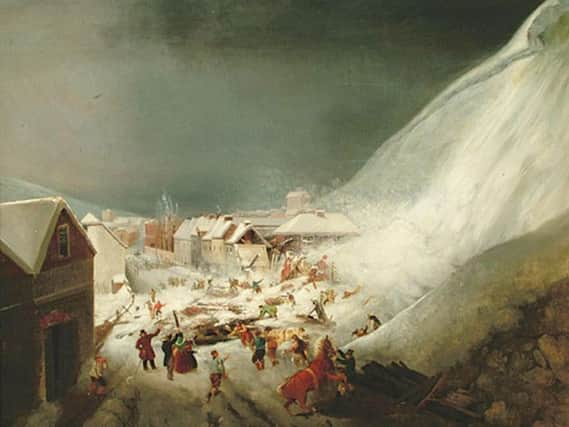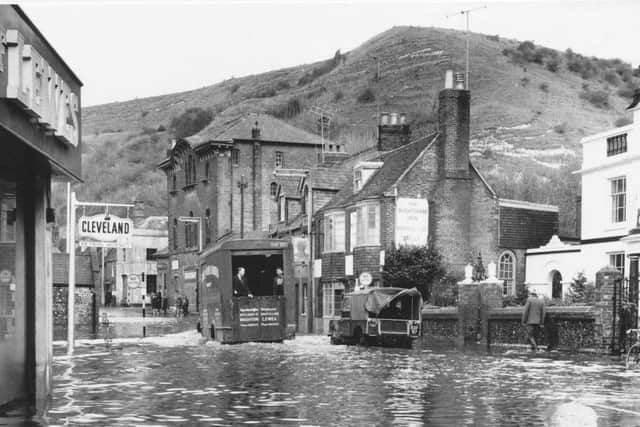The day Britain's most deadly avalanche struck Lewes


Certainly that’s the impression that most first-time visitors I’ve spoken to down the years get. Of course, there were turbulent times in the town’s history, most notably the Battle of Lewes in 1264 and the Marian persecutions during the reign of Mary I when 17 Protestants were burnt at the stake near the present-day war memorial.
“First timers” who come to our house are also invariably regaled with tales of the town’s acquaintance with natural disasters. Firstly, we tell them about how flood-prone Lewes is and how every 40 years or so when heavy rain over the Weald swells the Ouse and the river meets an incoming high tide of seawater then something has to give. That something occurs in the centre of town where the Ouse narrows to pass under Cliffe Bridge. The water level rises to the point where the river can no longer be contained and the inevitable result is disastrous flooding of low-lying areas. Streets become canals and surrounding fields turn into vast lakes.
Advertisement
Hide AdAdvertisement
Hide AdBut Lewes has also experienced another natural disaster, one that is unique in our island’s history. Britain’s deadliest-ever avalanche struck the county town in December 1836 when eight people lost their lives and another six were dug out alive thanks to frantic rescue efforts.


That winter had seen the whole of Britain experience appalling weather with freezing temperatures, heavy rain and gale force winds. On Christmas Eve a huge snowstorm engulfed southern England. Lewes was particularly hard hit. On the eastern side of the town there’s a very steep hillside, flanked by a chalk pit, that rises nearly 500 feet to the top of Cliffe Hill. The blizzard blew in from the northeast and piled the snow against the hillside. Enormous drifts built up towards the top. Locals said they resembled great waves upon the sea.
Between the foot of the hillside and the River Ouse is South Street, lined with houses on both sides. At the southern end was Boulder Row, the site of seven workers’ cottages. These were inhabited by poorer families and needy persons.
The threat posed to Boulder Row by the vast bank of snow was an obvious one and residents were advised to move out until the danger was past. Most people declined to move. On Boxing Day snow came crashing down onto a nearby timber yard and destroyed it. Even this event failed to alarm those folk who’d chosen to stay. Their reluctance to move may have been because they had been offered refuge in the Workhouse, a place that many considered to be hardly fit for human habitation.
Advertisement
Hide AdAdvertisement
Hide AdEarly next morning, ominous cracks were observed in the highest banks of snow. A local lad called Robert Hyam went along Boulder Row house by house to make yet another appeal for the inhabitants to evacuate. In the case of two women he actually took them by their arms and tried to lead them out. At this point he heard a rumbling sound emanating from on high. Fearing the worse, he rushed off to save himself. At 10.15am a massive expanse of snow slid down the hillside. Boulder Row’s seven end cottages took the full force of the avalanche. An eyewitness said that the snow had first crashed into the back yards and when it hit the houses from the rear they were hurled upwards as if there had been explosions beneath them. Even as the debris settled more snow was still sliding down and soon there was simply a vast heap of whiteness where the cottages had stood.
There were fifteen people inside the houses when the avalanche struck. A massive rescue effort was quickly mounted. Six people were dug out alive. The last survivor recovered was a young man called John Bridgeman. Even as he was being extricated, more snow came down and he found himself buried again along with some of his rescuers. It was a further six hours before Bridgeman was brought out; fortunately he had been partially protected from the weight of snow by house timbers that leant against a passageway wall.
Though dazed and injured, Bridgeman was able to point out where he thought his neighbour, Susan Hayward, was located. After frantic digging the rescuers were desperately disappointed to find the young woman had suffocated under the snow.
One of those rescued was two-year old Fanny Boakes. The white dress she was wearing when she was found is on display in the Anne of Cleves House museum in Lewes, along with a contemporary painting of the tragedy.
Advertisement
Hide AdAdvertisement
Hide AdAll but one of the avalanche victims were buried in a communal grave in South Malling parish churchyard. A public subscription raised money for a memorial tablet still displayed in the church and a fund was set up to aid the survivors and bereaved families.
In 1840 a pub was built on the site of Boulder Row. It’s still there. I think enough time has passed since the tragedy that we can forgive people smiling when they discover why it is called The Snowdrop. I’ve often added my own touch of black humour when I tell people it was once the scene of an avalanche but these days it’s a nice place to “av a lunch”.